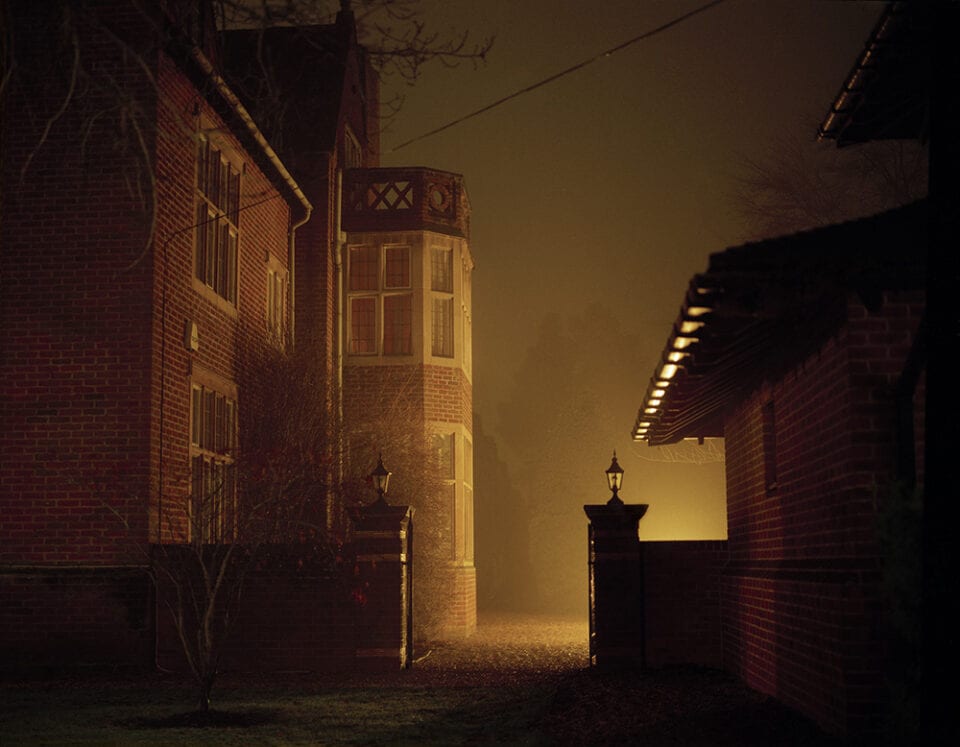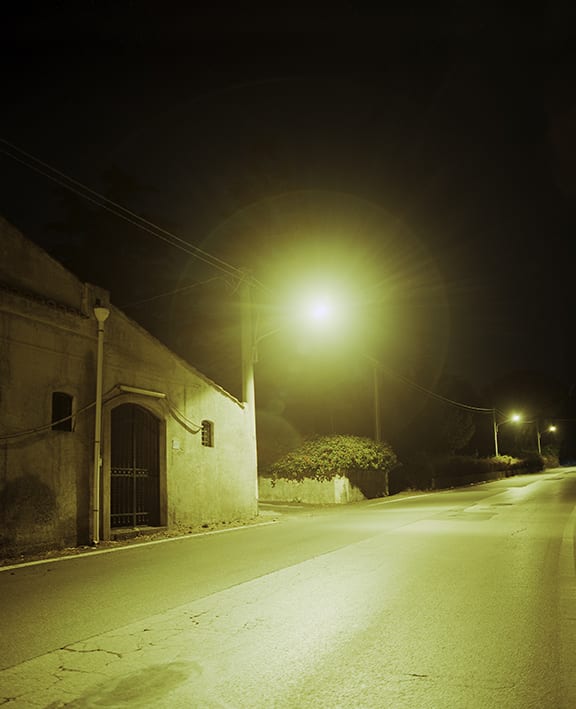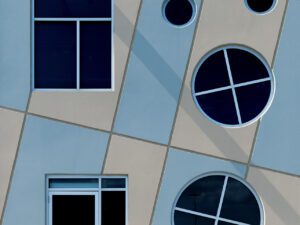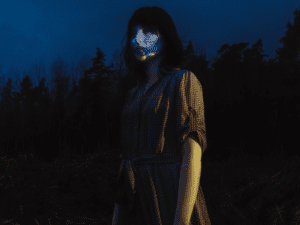Rachel Louise Brown is Photo Director at Harper’s Bazaar, a photographer and lecturer. She observes the world as a stage, creating photographs whilst exploring and experiencing unfamiliar places alone; often at night. As the explorations evolve, she casts strangers to fill the scenes. By capturing the psychology involved in these processes, Brown questions society’s construction of fear, gender and escapism.
A: Where did your journey into photography begin?
RLB: I grew up in Huddersfield, a town which, during my childhood, seemed bleak and lacking in opportunity. I was always looking for a way out – a way to spread my wings and find the world. Journalism was my initial passion. At 12, I won a competition to work at the local newspaper. I shadowed the staff photographer and knew instantly that photography would become my method of storytelling. Ironically my town is now a thriving place with a first-class university and photography department – at which I am a visiting lecturer!
A: Having come all this way, you’re now Photo Director of Harper’s Bazaar. What are some of the most important lessons you have learnt through this role, creatively, conceptually or logistically?
RLB: I’ve learnt many vital lessons over the last six years at Bazaar. It’s a fast-moving, inspiring environment where we make the impossible possible at the drop of a hat. I try to commission and produce shoots in a creative and sensitive manner – being mindful of the variety of opinions which need to be satisfied but also that we create engaging imagery which maintains the legacy of the publication and is celebratory of women. I try to ensure those involved in the shoots create work they can be proud of and that they feel valued, whether an emerging artist or more established.
A: What advice would you give to aspiring photographers today?
RLB: Do not give up and do not be afraid to go for something. There will be many setbacks along the way – many critics; many rejections – but the small successes will feel wonderful. Stay true to yourself and make work that satisfies you creatively. At some point, people will start to see your worth. Be mindful of diversity, equality and inclusion with those in front of your lens and within the teams around you. And, most of all, be aware of what you want to say and what your imagery projects.
A: How do your professional and creative roles intersect? Do they help inform each other?
RLB: The knowledge and skills acquired from one flow naturally to the other, like osmosis. My education has given a grounding in visual and art history – a knowledge of philosophy, politics and semiotics as well as training in the technical side of things. My professional career, in turn, gives me an insight into what’s happening within arts and culture now – as well as historically through Bazaar’s 152-year-old archive. Both my art practice and magazine role require a detective-like mindset – with research and negotiation key components involved in bringing a commission or a project to life.
A:You’ve noted that your photographs “observe the world as a stage” – how do you bring this idea into each of your projects?
RLB: In Shakespeare’s play As You Like it, he famously wrote “All the World’s a stage and the men and women merely players.” This idea flows throughout my work. I am fascinated with how we build our environments, how we perform within them and how they perform for us. Also, how the self is performed within society and for the camera, particularly how gender is constructed. I’m also interested how the self-interacts in society and for the camera – particularly with how gender is constructed. Most recently, I have been exploring ideas by French philosopher Jean Baudrillard – specifically his theories of Simulation and Hyperreality – when it becomes difficult to distinguish that which is real and that which is imaginary. This has included shooting what Baudrillard described as “imagination stations” in Florida – places such as Disneyland, Mar-a-Lago, The Holy Land, haunted houses and performers such as mermaids, strippers, ballerinas and gymnasts.
A: Mystery, film noir and theatricality seem to pervade many of your images – how do you think this heightened visual approach allows you to see the world in new ways?
RLB: I’m mesmerised by the mise-en-sceneof film and theatre, particularly how these works are framed and lit to evoke specific emotions in the audience. I make the majority of my work on artist residencies – exploring unfamiliar places often beginning the journey by wandering alone at night. This has taken on forms such as trespassing, spending the night in a haunted house, wandering the streets of an active volcano and taking self-portraits in a hotel notorious for drug use and prostitution. Once I’ve made these lone investigations, I then start photographing strangers in the local area found via casting calls.
I became addicted to this way of working in 2008. I had moved from the UK to New York to take part in a year-long artist residency at the School of Visual Arts. America was a figment of my imagination. I’d never been there before – my ideas and perception of the country was learnt through films and books. I couldn’t shake the feeling of displacement and strangeness; it was like living in a psychological thriller. Instinctively, I began working with my feelings, pushing them further. I wandered around in sleepy Upstate New York villages at night, photographing with a cumbersome medium format camera on a tripod. I’ll never forget seeing the first rolls of films. It was like a light bulb had gone on and I realised I could use my psychology as a sort of performance: a vessel for image-making.
A:What do you hope viewers take away from your work?
RLB: I would like for a sense of strangeness to provide a space for the viewer’s imagination to run amok – for them to work to decipher the narrative. I envision audiences questioning the construction of their environments: is everything a simulation?

A: How do you think the landscape of photography has changed, even in the last year?
RLB: The biggest shift – since I came to photography – was digital. It opened up a sense of immediacy, which is hugely beneficial for commercial and editorial clients. There are no more pre-light days; everything can be done much quicker and with greater volume. Though it has made life as a Photo Director a little more time consuming as sometimes the edits can be huge. I’m still an advocate for film and with my personal work I harness the slowness of it; this is very much part of the psychology behind the images. Photography then experienced a liberation with the #MeToo movement which thankfully removed the predators who exploited those they photographed. Now, it’s the Black Lives Matters movement, which will do great work in ensuring all those responsible for giving a platform to others do so in a way that is truly equal and reflective of our diverse society.
A: What are you most excited about with joining Wren?
RLB: I’m thrilled to have been signed by Wren. I’ve admired the agency for a while. I’m most excited about collaborating with the team, seeing where they think my aesthetic may work and the partnerships that come to life. Jennifer, Wren’s Founder, has an addictive passion for photography and a complete understanding of visual language and its history. Pre-launch, during lockdown, she put me forward for a brand’s isolation project. Working creatively during those early weeks made things more bearable.
A: What other projects are you working on in 2020 and 2021?
RLB: I had been working on a project with the Household Cavalry which went on the back burner because of the pandemic, but I am hoping to get this going again. It’s a behind the scenes look at the renowned British institution, in particular its recent first-time recruitment of female officers. It’s fascinating to see the behind the scenes workings of the Cavalry and also the individuals behind the collective. I’m also hoping to continue my long-term body of work Simulationsin Las Vegas. I can think of no better place to evolve and explore ideas of hyperreality and escapism.
IG: @rachellouisebrown1 | @wrenagency
rachel-brown.com | wren.agency
Credits: Rachel Louise Brown c/o Wren Agency.
1. The Street, West Palm Beach. From the series Simulations (2014).
2. Shadows Falling. From the series The Ballad of Fire Mountain (2014).
3. Looking Out to the Mainland. From the series The Ballad of Fire Mountain (2014).
4. The Town House. From the series The Malevolent Eye (2010).
5. The Abandoned Altar. From the series The Ballad of Fire Mountain. (2014).
6. The Street. From the series The Ballad of Fire Mountain (2014).
7. The Boarding School. From the series The Malevolent Eye. (2010).










